Cemented and Cementless Knee Replacement
Total knee replacement is one of the most commonly performed joint replacement surgeries. Total knee arthroplasty (TKA) is a surgical procedure to replace diseased ends of the knee joint with prosthetic materials. Traditionally knee replacement surgery has been performed used cemented prosthesis. Recently however a number of cementless total knee replacement surgeries are being done with excellent results.
There has been a constant debate between cemented and cementless knee replacement. Compared to cemented prosthesis cementless prostheses have been proposed to have long term survivorship. Cementless implants have a biological fixation with bone growth.
Knee Anatomy & Arthritis
The knee joint is formed by the lower end of the thigh bone and the upper end of the shinbone. The kneecap (patella) sits in a groove between the distal end of the thigh bone (femur). A proper alignment between all the bones it necessary for optimal function of the joint.
The articulating cartilage is a shiny glistening white fibrous tissue present on the ends of the bones forming the joint. The cartilage not only acts as a cushion for the joint but also helps in smooth gliding movements of the knee. The medial and lateral meniscus are small pads of tissues present between the femur and tibia. The menisci provide stability and cushion against impacts.
There are various ligaments supporting the knee to prevent laxity during joint motion. The anterior cruciate ligament and the posterior cruciate ligament provide stability mainly in the front and the back. The medial collateral ligament and the lateral collateral ligament provides stability on the sides of the knee joint.
Arthritis remains the most common cause of knee pain in the elderly requiring replacement. Arthritis could be due to degenerative wear and tear known as osteoarthritis. Inflammatory causes of arthritis are rheumatoid arthritis and psoriatic arthritis.
Injury or trauma to the structures forming the knee joint can also cause early arthritic changes in the knee. Malalignment of the knee joint or the kneecap can also result in arthritis. Instability due to the laxity of the ligaments may also result in early arthritic changes in the knee joint.
Total knee replacement is done when all other conservative forms of management have been exhausted. There is an increasing trend of total knee replacement owing to the success of the surgery. Patients in all age groups have had a total knee replacement with excellent results and early return to daily activities.
Cemented Total Knee Replacement
After the patients are medically cleared for surgery and received appropriate anesthesia, the knee joint is opened from the front. The diseased segments of the bones forming the joint are removed. Using cutting guides, bone cuts made in the femur, tibia and the patella.
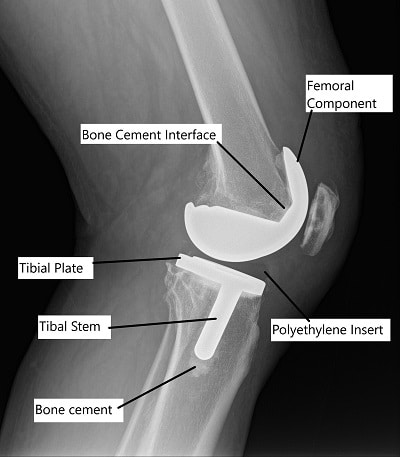
Cemented TKA
After thoroughly washing the cut segments, acrylic bone cement is applied to the implants and the bone segments. The implants are then fixed to the prepared bed on the bone.
A plastic high-quality polyethylene space is attached to the tibial component to reduce friction between the implants. The acrylic cement hardens quickly providing immediate fixation.

Constrained polyethylene insert
A constrained polyethylene insert may be used in a knee with ligament instability on the sides. The tall and wide tibial post on the polyethylene insert ensures rotational and small side to side stability. The insert is made of highly cross-linked polyethylene which is resistant to wear and tear. The tibial post fits in front of the femoral cam providing stability.
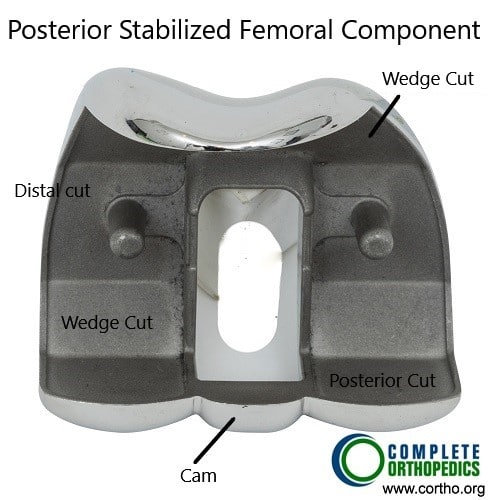
Femoral Component (posterior stabilized)
The posterior stabilized femoral component involves sacrificing the posterior cruciate ligament during surgery. The function of the posterior cruciate ligament is duplicated by the femoral cam and the tibial post mechanism.

Modular femoral component
The non constrained posterior stabilized polyethylene insert has a tibial post that works along with femoral cam to provide femoral rollback. The polyethylene is highly cross linked and treated with anti-oxidants to prevent wear and particles.
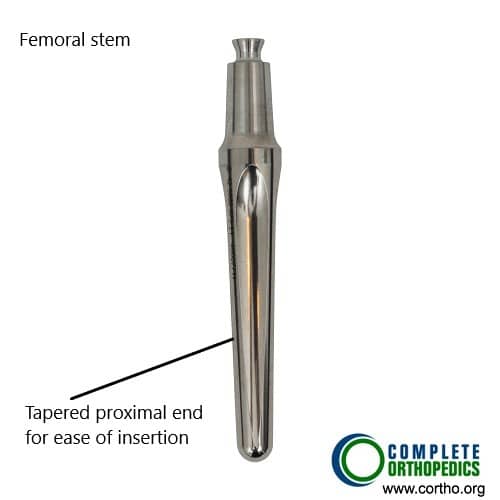
Modular femoral stem
The femoral stem fits in a modular femoral component and is used in revision surgery to achieve greater stability of the prosthesis. The stem is not cemented while the modular femoral component is cemented in the lower thigh bone.
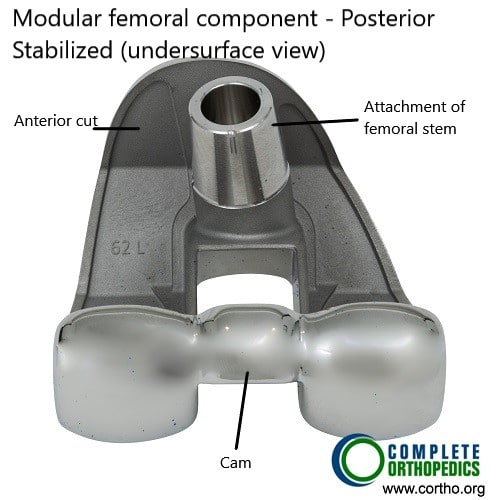
Modular femoral component
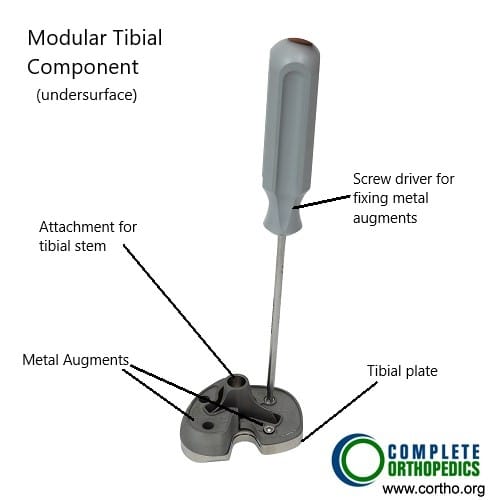
Modular tibial component with bone augments (metal wedges)
Similar to modular femoral component, a modular tibial component is used in revision knee replacement. The modular components allow attachment of stem and bone augments (metal cones/wedges) to achieve stable fixation and stabilize the prosthetic knee in all ranges of motion.
Cementless Total Knee Replacement
The surgical steps remain the same, however, the femoral and tibial components are press-fitted on the bones. The implants are specially designed to have a porous surface to allow for bone growth. The patella is cemented due to high rates of failure with cementless fixation.
The bone cuts have to be accurate in case of cementless tka for the implant to be press-fitted. Screws or pegs are used for additional fixation in case of the tibial component.
Advantages & Potential Drawbacks of Cemented Fixation
The acrylic cement dries very quickly providing immediate fixation. The cemented implants have been in use for many years now with a significant date on their success. On average, the cemented total knee prosthesis lasts for 15-20 years or more.
The cement provides excellent fixation in the case of osteoporotic or weak bones. Cemented implants provide a better fixation in old, obese, osteoporosis, cancer patients with poor bone quality.
Over a period of time, the cement which forms a layer between the bone and the implant may become loose. In younger patients, a high amount of stress on the joint may also cause loosening of the bone cement.
Once the cement begins to come loose, the implant loosens and may rub against the bone causing pain. Loosened implants frequently require revision surgery. The revision surgery is also complicated by the presence of cement.
The cement may also cause third body wear. Small fragments of the cement may break in and rub against the implants. The particles may also lead to inflammation as the body tries to remove the debris.
This may lead to a condition known as osteolysis as the inflammatory cells may also remove the bone around the implant. The loosened implant may again require revision.
As the bone cement hardens, it releases a lot of thermal energy. The heat may damage the underlying bone surface causing thermal necrosis. Additionally, the process of cementing may lead to increased chances of fat embolism.
Advantages & Disadvantages of Cementless Fixation
Cementless implants are press-fitted into the bone, as they have a special porous surface to stimulate bone growth. The bone growth happens over a long period of time thus not providing immediate fixation. As they promote biological fixation, they are proposed to have longer survivorship.
The limitations of cement fixation are not present in cementless fixation. The cementless fixation although needs good bone stock. Young patients with good bone metabolism are the ideal candidate for cementless fixation.
However, cementless fixation requires accurate bone cuts to prevent any gaps between the implant and the bone surface. The surgery time for cementless fixation is significantly less than the cemented fixation. The chances of osteolysis are reduced in cementless fixation but the microscopic particles from the implant may still lead to osteolysis.
The revision surgery for cementless implants is much easier due to the availability of good bone stock. Although there are fewer problems of cementless fixation they have in use only recently. The long term advantages and drawbacks are yet not fully understood.
With the advancement in implant materials, there is a growing interest in the cementless fixation of knee implants. Hybrid fixations have also been done where the femoral component is fixed cementless and the tibia is fixed with bone cement.
Comparing the Two Methods
When deciding between cemented and cementless knee replacement, several factors come into play. Cemented knee replacements offer immediate stability and have a long track record of success. However, there is a small risk of cement-related complications, such as allergic reactions or bone cement implantation syndrome. On the other hand, cementless knee replacements provide a more biologic fixation and may be preferred for younger patients or those with good bone quality. However, they may require a longer recovery period as the bone needs time to grow into the implant surfaces.
Factors to Consider: When discussing knee replacement options with your orthopedic surgeon, several factors should be taken into consideration:
Age and Activity Level: Younger, more active patients may benefit from cementless knee replacements, as they provide excellent long-term stability and durability.
Bone Quality: Patients with poor bone quality may be better suited for cemented knee replacements, as the cement provides immediate fixation and stability.
Surgical Technique: The surgeon’s experience and preference may also play a role in determining the best approach for your knee replacement surgery.
Long-Term Success Rates: Both cemented and cementless knee replacements have been shown to have good long-term success rates, but individual outcomes may vary.
Complications of Joint Replacement
As with any surgery, there may be potential complications of joint replacement surgery. There may be medical complications including stroke, heart attack, pneumonia or urinary tract infections. During the surgery, there may be complications such as fractures, nerve damage, blood vessel damage, shortening, instability or dislocation.
After the surgery, during the first few weeks, there is an increased risk of infections which may be superficial or deep. There may be complications of joint dislocation or blood clots in the blood vessels. Blood thinners are usually prescribed after the surgery to prevent blood clots. In the long term, there may be persistent pain, weakness, dislocation or loosening of the implant.
Outcome
Total knee and hip replacements are one of the most successful surgeries in modern medicine. Joint replacement surgery usually lasts for many years. With advances in materials, implants, and techniques the lifespan of the surgery is further proposed to increase.
Cementless and cemented total knee replacements are both successful surgeries depending upon the needs of the patient. Adequate patient selection through physical examination and imaging is important before opting for cemented or cementless total knee replacement.
Do you have more questions?
What are the main differences between cemented and cementless knee replacements?
The main difference lies in how the artificial components are secured to the existing bone. Cemented knee replacements use bone cement for immediate fixation, while cementless knee replacements rely on bone ingrowth for biological bonding over time.
Is one method generally preferred over the other?
There isn’t a one-size-fits-all answer. The choice between cemented and cementless knee replacements depends on factors like patient age, bone quality, and surgeon preference.
Are there any specific risks associated with cemented knee replacements?
While cemented knee replacements have been used successfully for many years, there is a small risk of complications related to the bone cement, such as allergic reactions or bone cement implantation syndrome.
What are the benefits of cementless knee replacements?
Cementless knee replacements offer a more biologic fixation, which can be advantageous for younger, more active patients. They also eliminate the risk of complications related to bone cement.
How long does it take for bone to grow into the porous surfaces of cementless knee replacements?
Bone ingrowth typically occurs over several months to a year after surgery, gradually providing stability and durability to the implant.
Are cementless knee replacements suitable for all patients?
While cementless knee replacements can provide excellent long-term stability, they may not be suitable for patients with poor bone quality or certain medical conditions.
Do cemented knee replacements have a higher risk of loosening over time?
While loosening can occur with any type of knee replacement, cemented knee replacements have a proven track record of long-term success and stability for many patients.
How do surgeons determine which type of knee replacement is best for a particular patient?
Surgeons consider factors such as patient age, activity level, bone quality, and their own experience and preference when determining the most appropriate approach for knee replacement surgery.
Can a patient switch from one type of knee replacement to another if needed?
While it’s technically possible to revise a knee replacement from cemented to cementless or vice versa, it’s a more complex procedure with its own set of risks and considerations.
Are there any lifestyle changes or precautions needed after knee replacement surgery?
Patients typically undergo physical therapy and rehabilitation to regain strength and range of motion in the knee. They may also need to avoid certain high-impact activities to prolong the life of the implant.
What is the typical recovery time after knee replacement surgery?
Recovery time can vary depending on factors like surgical approach, patient age, and overall health. Generally, patients can expect to resume light activities within a few weeks and gradually increase activity levels over several months.
How common are complications with knee replacement surgery?
While knee replacement surgery is generally safe, there are risks of complications such as infection, blood clots, and nerve damage. However, these risks are relatively low and can be minimized with proper pre-operative evaluation and surgical technique.
Can knee replacements wear out over time?
While knee replacements can experience wear and tear over time, modern implants are designed to withstand the demands of daily activity for many years. Regular follow-up appointments with the orthopedic surgeon can help monitor the condition of the implant.
How soon can patients expect to return to normal activities after knee replacement surgery?
Recovery times can vary, but most patients can expect to return to light activities within a few weeks and gradually increase activity levels over several months. Full recovery may take several months to a year.
Are there any limitations on physical activity after knee replacement surgery?
While patients can typically resume low-impact activities like walking, swimming, and cycling after knee replacement surgery, they may need to avoid high-impact
What should patients expect during the initial consultation with an orthopedic surgeon for knee replacement surgery?
During the initial consultation, the orthopedic surgeon will evaluate the patient’s medical history, perform a physical examination, and discuss treatment options, including the risks and benefits of knee replacement surgery.
How can patients prepare for knee replacement surgery?
Preparing for knee replacement surgery may include lifestyle modifications, such as quitting smoking or losing weight, as well as arranging for assistance with daily tasks during the recovery period. The orthopedic surgeon will provide specific pre-operative instructions based on the patient’s individual needs.
My name is Dr. Suhirad Khokhar, and am an orthopaedic surgeon. I completed my MBBS (Bachelor of Medicine & Bachelor of Surgery) at Govt. Medical College, Patiala, India.
I specialize in musculoskeletal disorders and their management, and have personally approved of and written this content.
My profile page has all of my educational information, work experience, and all the pages on this site that I've contributed to.

